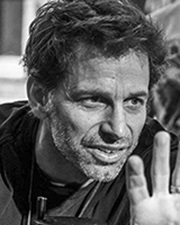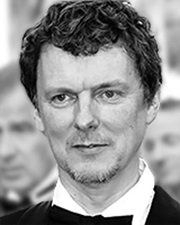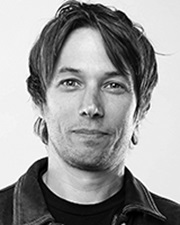GADGETS
By David Heuring
With the introduction of the iPhone 11 Pro—with its astonishingly good camera, along with the raft of ingenious apps and supporting gear like FiLMiC Pro, lens adaptors and stabilizers—has the camera phone become a legitimate professional motion picture camera? As always with filmmaking, it likely depends on the skills, experience and mindset of the person using it.
Zack Snyder's curiosity was piqued when he was considering teaching a basic filmmaking class at ArtCenter College of Design in Pasadena. "In order to make the students really dig down and not worry about the gear, I wanted to make them shoot and edit one movie on their phones, to just make it cool with what they've got right now," says the director. "I realized that I had never done that, so I wanted to make a movie quickly in order to troubleshoot and relate to the issues. I had an amazing experience, and as far as I'm concerned, as a tool, it works."
 The resulting enigmatic short, Snow Steam Iron, was made in two days. Snyder, who worked as a director-cameraman for 11 years prior to his feature directing career, reconnected with his cinematography roots on the project. He used the 1080p setting in order to facilitate high-speed capability, reasoning that images meant for viewing on a phone don't need more resolution anyway. In terms of crew, supporting equipment and postproduction, Snyder approached the project as he would any other. He made extensive use of the FiLMiC Pro image control app, as well as the Beastgrip Pro lens adaptor and rig system, DJI Osmo Mobile 3-axis gimbal stabilizers, and ExoLens by Zeiss.
The resulting enigmatic short, Snow Steam Iron, was made in two days. Snyder, who worked as a director-cameraman for 11 years prior to his feature directing career, reconnected with his cinematography roots on the project. He used the 1080p setting in order to facilitate high-speed capability, reasoning that images meant for viewing on a phone don't need more resolution anyway. In terms of crew, supporting equipment and postproduction, Snyder approached the project as he would any other. He made extensive use of the FiLMiC Pro image control app, as well as the Beastgrip Pro lens adaptor and rig system, DJI Osmo Mobile 3-axis gimbal stabilizers, and ExoLens by Zeiss.
"The iPhone delivered exactly what I expected it to," Snyder says. "The versatility and dynamic range looked very good, considering. We made a DCP and projected it on the big screen, which was great. That was two years ago, and now the iPhones are even better."
Michel Gondry made Detour, an endearing short, with director of photography Laurent Brunet. Gondry says that when it comes to imagery, the camera matters less than the human relationships.
 "There's a strong bond and complicity that goes beyond the equipment," says Gondry. "If I work with a DP, I will trust that person, otherwise there is no point."
"There's a strong bond and complicity that goes beyond the equipment," says Gondry. "If I work with a DP, I will trust that person, otherwise there is no point."
Brunet used a stabilizer to obviate the need for a dolly track, and an adjustable polarizing filter to control exposure. Smartphones generally control the amount of light by changing the time of the exposure, so bright, sunny exteriors can sometimes take on a Saving Private Ryan-style shutter effect. Also, the compression can struggle with hot highlights. The polarizing filter prevented this problem—important given the film's exterior settings.
"I learned that the picture looks good on a big screen," says Gondry. "We had a crew, so the production was still a bit heavy. I think that the most important thing for me was the locations we could access by using the iPhone. It's the place in France where I spent most of my holidays. I always wanted to shoot there but the producers would say no each time, because it's in the mountains and access is quite tricky. So this time I could go there—and only I can tell you how happy it made me."
Sean Baker, whose Tangerine made the idea of shooting a movie on an iPhone go from novelty to practicality, says that the introduction of the essential FiLMiC Pro app was a very important step in the process of the iPhone's evolution from an inexpensive way to get a film made to a bona fide stylistic choice.
 "With Tangerine, it was a combination—there was a new medium out there, something much cheaper that I already owned, and all these third parties started to jump in." he says. "Moondog Labs created these great anamorphic lens tools. I was making a film capped at $100,000, so I had to find a way to make it work. I needed to make it more than just a stunt. Once we began entertaining the thought of shooting on an iPhone, we started to dream up how it would complement and elevate the content—the aesthetic."
"With Tangerine, it was a combination—there was a new medium out there, something much cheaper that I already owned, and all these third parties started to jump in." he says. "Moondog Labs created these great anamorphic lens tools. I was making a film capped at $100,000, so I had to find a way to make it work. I needed to make it more than just a stunt. Once we began entertaining the thought of shooting on an iPhone, we started to dream up how it would complement and elevate the content—the aesthetic."
On the narrative feature The Florida Project (2017), Baker shot mostly on celluloid, which he generally considers more aesthetically pleasing than digital. For a few key scenes, he used an iPhone to suggest a jump from realism to fantasy. Over the course of three projects—Tangerine, Snowbird (a short film presenting a fashion line shot on iPhone 7) and The Florida Project—Baker saw the format maturing.
"It's getting better every year, and every time there's an update with tools like FiLMiC Pro, they're making leaps and bounds with what you can accomplish," he says. "Exposure has gone up and down as they jumped from HD to 2K and 4K but has balanced out again. The workflow is improving, and with the new iPhone 11's three lenses, it's genuinely revolutionary. You can do things that have never been don—shoot two angles or two different focal lengths at the same time. If you're doing an interview, you already have double the coverage, which is invaluable for documentary filmmakers. I'm in development on a new film, and I'm using the iPhone and FiLMiC Pro all the time for my research."
Snyder adds: "I think the tool is capable of whatever you bring to it with your imagination and your ability to create. Most cameras have pluses and minuses, and hopefully are just there to help you express a point of view. I don't think that the potential of the phone camera has been fully realized. We're waiting to discover how we can be blown away by it."